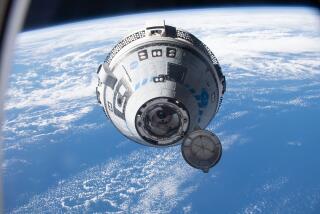How NASA practiced pulling Orion from sea
You have built a multibillion-dollar spaceship that will one day take humans to asteroids and Mars. You have big plans to send it up 3,600 miles into orbit, or about 15 times farther than the International Space Station. Now comes the hard part: Recovering this major piece of equipment once it lands.
On Monday, NASA, along with a team from Lockheed Martin and the U.S. Navy, boarded the USS Anchorage at San Diego Naval Base to take a practice run at recovering the Orion â the space agencyâs latest achievement in deep-space exploration â from the sea.
The craft, a multipurpose crew vehicle that looks something like a giant triangular robot sent from space, is set to take its first unmanned flight in December. Orion will climb 3,600 miles into orbit, make one trip around the world and fall back to Earth traveling about 20,000 mph. The moduleâs exterior will reach nearly 4,000 degrees before the craft is slowed down with the help of several parachutes and finally splashes down in Southern California waters.
âIâm not sure Americans particularly grasp the significance of whatâs going to happen,â NASA Administrator Charles Bolden told the Los Angeles Times while aboard the Anchorage. âThe most powerful nation in the world will be sending a spacecraft intended to carry humans farther than weâve been in 40 years. We have not designed a spacecraft to do this since the Apollo era. So when we launch in December, it will be something that a whole generation of Americans have not seen.â
The type of effort needed to retrieve the Orion also will be a first for NASA. That is why, when word got out about NASAâs plans to build Orion, the U.S. Navy wanted to be there for its recovery.
âThe Navy was there during the Apollo, so when the Orion came up, we raised our hand and said, âListen, we can do this mission,â â U.S. Navy Rear Adm. Fernandez Ponds told The Times.
According to Ponds, there is no better ship for the recovery of Orion than the Anchorage, with its radar, flight deck, robust medical facility and all-important well deck, an area of the ship that can take on water to allow boats -- and in this case the Orion -- to dock inside the ship.
On Monday, Michael Bolger, manager of the ground systems development and operations program at the Kennedy Space Center in Florida, laid out how the recovery would work:
When Orion splashes down, the Navy will send out Zodiac ships filled with divers to meet it. The divers will attach a series of straps so that Anchorage can attach a winch line to reel the craft in, âalmost like a fishing line.â While the module is being reeled in, smaller vessels will be on each side of it, with crews to tend lines centering the craft.
The well deck will open, filling with about 6 feet of water. Once the module is safely inside, the well will drain out.
At this point, if the Orion were manned, the astronauts would be able to step out.
In several years when the Orion takes its first manned flight, the entire recovery operation will have to take place in less than two hours to ensure the comfort and safety of the astronauts.
NASA and the Navy have tried one other method for recovery, which involved a crane to lift the module out of the water and place it on the ship. A similar method was used to recover the Apollo modules.
Milt Heflin, a retired NASA employee who participated in eight Apollo recoveries, says that although the crane method might be easier, the device would be too heavy for Orion.
âAnything you do like that adds weight to the spacecraft,â said Heflin, who is affectionately referred to as âthe sageâ as he consults on the Orion recovery efforts. Without the crane and lifting loop, a giant hook built on top of the module, this recovery became âmuch more difficult than what we were doing.â
Difficult, yes, but Orion has had previous stumbling blocks. At one point, the entire program was scrubbed.
In early 2010, the Obama administration canceled the Constellation program, of which the Orion was a part.
According to the Denver Post, the Obama administration described the Constellation program as being âover budget, behind schedule and lacking in innovation.â
But later that year, the president signed the NASA Authorization Act 2010, effectively saving the Orion program but bringing an end to the larger Constellation program.
âOur nationâs leaders have come together and endorsed a blueprint for NASA,â Bolden told reporters at the time, âone that requires us to think and act boldly as we move our agency into the future. This legislation supports the presidentâs ambitious plan for NASA to pioneer new frontiers of innovation and discovery.â
Heflin said of government support for the program: âYou canât do this in fits and starts. Youâve got to have sustained commitment.â
He said Orion brought more to the American public than the possibility of deep-space travel. âIt makes them feel good from time to time. And there is nothing wrong with doing something that the American public can be proud of.â
On Mondayâs practice run at recovering Orion, the Anchorage spent several hours traveling out to sea. There, it met up with another vessel, which carried one of four mockups of the spaceship Orion and dropped it into the ocean via a crane.
The recovery soon got underway.
After some mechanical difficulties with one of the Zodiac ships, divers met up with the module. Line tenders in the smaller vessels then positioned the module behind the Anchorage.
Lining up the module to safely reel it in was tedious. At one point, line tenders were seen manually pulling the Orion into place behind the Anchorage.
Slowly but surely, the module made its way into the well deck of the Anchorage. Once the water drained away, there sat the module â a craft that looked far too small to carry six humans into deep space and back.
Those aboard the Anchorage, of course, were confident in Orionâs upcoming unmanned -- and one day manned -- missions.
âWill we get there? I believe we will,â Bolden said. âThere are a lot of people who donât think so, but I happen to believe we will.â







